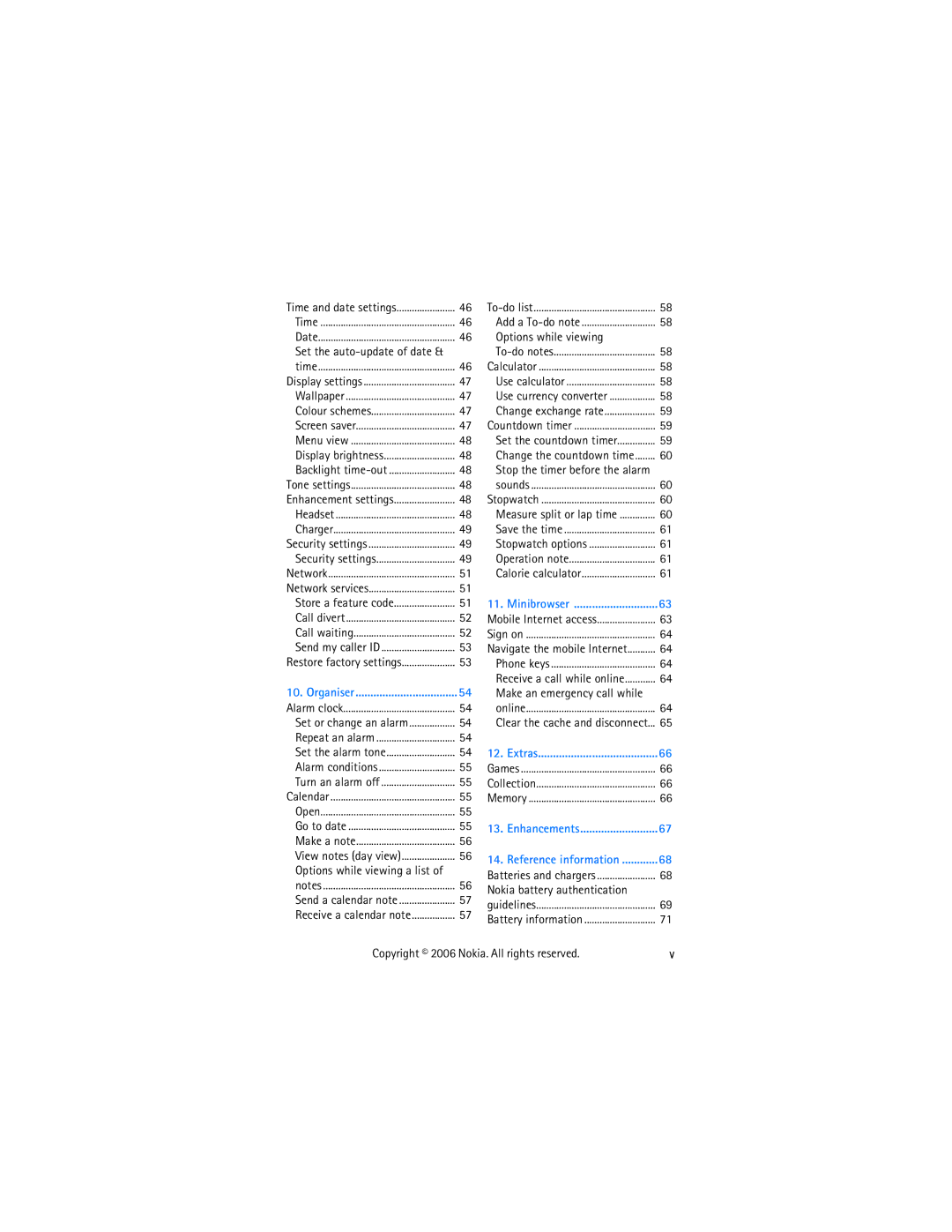Nokia 2355 User’s Guide
Copyright 2006 Nokia. All rights reserved
Ii Copyright 2006 Nokia. All rights reserved
Contents
Iv Copyright 2006 Nokia. All rights reserved
Delete text or multimedia
Send and receive contacts
Options while viewing
Nokia battery authentication
Vi Copyright 2006 Nokia. All rights reserved
Additional safety information
Read these simple guidelines
For your safety
Only qualified personnel may install or repair this product
Viii Copyright 2006 Nokia. All rights reserved
Network services
About your device
Shared memory
Welcome
Nokia support and contact information Updates
Getting help
Find your phone label
Device keys, indicators, and connectors
Standby mode
Phone at a glance
Open the fold
Quick keys
Indicators and icons
Phone menus
Your phone keypad is locked
Security code settings
User interface features
Scroll method
In-phone help
Go to functions
UIM SIM card and battery
Set up your phone
Insert the battery
Antenna
Turn your phone on and off
Charge the battery
Plug the charger transformer into a standard ac outlet
Disconnect the charger from the device and the ac outlet
Using the contacts list
Using the keypad
Using the last dialled number
Make a call
Answer calls
Using the loudspeaker
Answer or silence an incoming call
Answer a call with the keypad locked
Lock the keypad keyguard
Text entry
Standard mode
Predictive text mode
Activate and deactivate
Change case and mode
Enter text
Press 1 to insert a period into your message
To delete text, use one of the following options
Delete text
S s a g e s
Messages
Write and send
Text messages
Templates
Options
Change sending options
Read and reply
Select Options Reply
Select Options Send
Options and the setting you want to change
Change other settings
Select the setting you wish to change
Distribution lists
Save messages to folders
Text message folders
View saved messages
Send a message
Multimedia messages
Sending options
Reading options
Set contrast-Adjust the contrast of the image
Writing language-Choose
Multimedia message received appear
Message details-View the message Subject, size, and class
Multimedia message settings
Delete message-Delete a saved message
Multimedia message folders
Single message
Delete text or multimedia messages
Select Save message Saved items
Save voice mailbox number
All SMS messages in a folder Voice messages
All MMS messages in a folder
Listen to your voice messages
Call and setup your voice mail
Clear voice mail icon
Automate voice mail
Insert dialling codes
Setup voice mail with dialling codes
Minibrowser messages
Scroll to an empty speed dial slot and select Assign
View missed calls
Call register
View received calls
Send message-Sends a message to the number
Call duration
Delete call register
View dialled numbers
View call times
Minibrowser duration
Add new contacts
Contacts
Assign a voice tag to an entry
Before using voice tags, note that
Voice dialling
Delete
Dial a number
Options
Change
Edit contacts list entries
Set up speed dials
Assign a key to speed dials
Change speed dials
Edit the option to your preference, and select OK
Delete contacts list entries
Add voice tag-Add a voice tag to the contact
View Contacts
Configure settings
Search for a name
Add number-Add a number to an existing name
Send a business card
Send and receive contacts business cards
Open the gallery
Gallery
View folders
Delete folder-Delete a folder you have created
Radio
Media
Turn the radio on and off
Use the radio
Record speech or sound
Voice recorder
Save a radio channel
Then tune to that station with the 4-way scroll key
Scroll to any recordings you created
Profiles
Settings
Activate a profile
Personalise a profile
Personal shortcuts
Call settings
Automatic redial
Automatic update of service
Speed dialling
Calling card
Language settings
Phone settings
Call summary
Dtmf tones
Start-up tone
Welcome note
Help text activation
Set type
Add a voice command
Voice commands
Activate a voice command
Voice command options
Set the auto-update of date & time
Time and date settings
Time
Date
Wallpaper
Display settings
Colour schemes
Screen saver
Display brightness
Menu view
Backlight time-out
Headset
Security settings
Security settings
Charger
Phone lock
Call restrictions
Change lock code
Enter the lock code, and select OK
Select Change lock code
Network
Store a feature code
Call from it, and send the caller to the voice mail
Select Call restrictions
Call divert
Cancel
Call waiting
Activate
Send my caller ID
Restore factory settings
Set or change an alarm
Alarm clock
Repeat an alarm
Set the alarm tone
Turn an alarm off
Alarm conditions
Calendar
Open
View notes day view
Make a note
Options while viewing a list of notes
Select Options View day
Receive a calendar note
Send a calendar note
View notes
Save notes
Calculator
To-do list
Add a To-do note
Use calculator
Set the countdown timer
Countdown timer
Enter a note for the timer, and select OK
Change exchange rate
After you have set the timer, you can change the time
Stop the timer before the alarm sounds
Stopwatch
Measure split or lap time
Save the time
Calorie calculator
Stopwatch options
Operation note
Edit and delete activities
Select an activity
Minibrowser
Mobile Internet access
Navigate the mobile Internet
Sign on
Phone keys
Make an emergency call while online
Clear the cache and disconnect
Games
Extras
Collection
Memory
With this
Enhancements
Check
Batteries and chargers
Reference information
Authenticate hologram
Nokia battery authentication guidelines
Copyright 2006 Nokia. All rights reserved
Talk and standby times
Battery information
Charging times
Use chargers indoors
Care and maintenance
Operating environment
Additional safety information
Medical devices
Not carry the device in a breast pocket
Vehicles
Potentially explosive environments
Certification information SAR
Call. Consult this guide or your service provider
Emergency calls
Copyright 2006 Nokia. All rights reserved
Index
ESN Exchange rate 59 Extras Feature codes Gallery
Menu view Grid 48 list Messages delete
Headset 7, 48 Help
Network
Shared memory ix SIM card 5 Speed dials 32 Standby
Adjusting Using the loudspeaker
